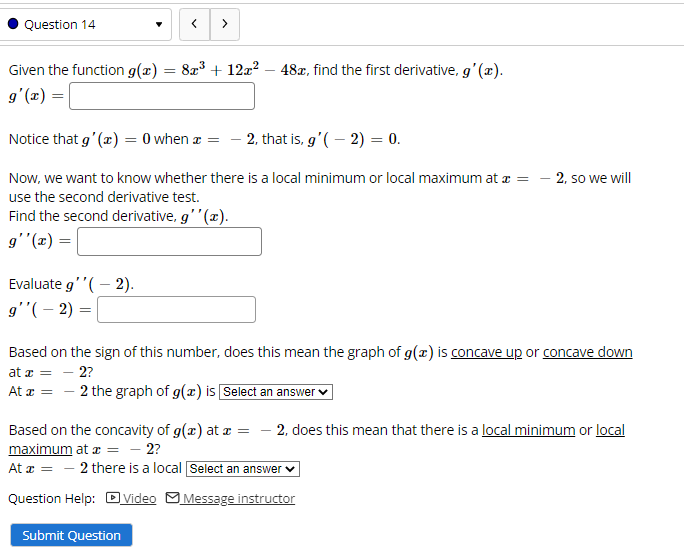Given the function g(x) = 8x³ + 12² – 48x, find the first derivative, g' (x). g'(x) = Notice that g'(x) = 0 when æ = - 2, that is, g'( – 2) = 0. Now, we want to know whether there is a local minimum or local maximum at æ = - 2, so we will use the second derivative test. Find the second derivative, g''(x). 9'"(x) = Evaluate g''( – 2). 9'"(- 2) = Based on the sign of this number, does this mean the graph of g(x) is concave up or concave down at a = - 2? At æ = - 2 the graph of g(æ) is Select an answer ♥ - 2, does this mean that there is a local minimum or local Based on the concavity of g(x) at æ maximum at a = - 2? At a = - 2 there is a local Select an answer Question Help: D Video OMessage instructor
Given the function g(x) = 8x³ + 12² – 48x, find the first derivative, g' (x). g'(x) = Notice that g'(x) = 0 when æ = - 2, that is, g'( – 2) = 0. Now, we want to know whether there is a local minimum or local maximum at æ = - 2, so we will use the second derivative test. Find the second derivative, g''(x). 9'"(x) = Evaluate g''( – 2). 9'"(- 2) = Based on the sign of this number, does this mean the graph of g(x) is concave up or concave down at a = - 2? At æ = - 2 the graph of g(æ) is Select an answer ♥ - 2, does this mean that there is a local minimum or local Based on the concavity of g(x) at æ maximum at a = - 2? At a = - 2 there is a local Select an answer Question Help: D Video OMessage instructor
Calculus: Early Transcendentals
8th Edition
ISBN:9781285741550
Author:James Stewart
Publisher:James Stewart
Chapter1: Functions And Models
Section: Chapter Questions
Problem 1RCC: (a) What is a function? What are its domain and range? (b) What is the graph of a function? (c) How...
Related questions
Question

Transcribed Image Text:Question 14
>
Given the function g(x) = 8x3 + 12a? – 48x, find the first derivative, g' (x).
g'(x) =
Notice that g' (x) = 0 when a = - 2, that is, g'( – 2) = 0.
Now, we want to know whether there is a local minimum or local maximum at z = - 2, so we will
use the second derivative test.
Find the second derivative, g'" (x).
g'"(x) =
Evaluate g''( – 2).
g'"(– 2) =
Based on the sign of this number, does this mean the graph of g(x) is concave up or concave down
at z = – 2?
At r = - 2 the graph of g(x) is Select an answer
- 2, does this mean that there is a local minimum or local
Based on the concavity of g(x) at a =
maximum at æ = - 2?
At a = - 2 there is a local Select an answer v
Question Help: DVideo MMessage instructor
Submit Question
Expert Solution
This question has been solved!
Explore an expertly crafted, step-by-step solution for a thorough understanding of key concepts.
Step by step
Solved in 2 steps

Recommended textbooks for you

Calculus: Early Transcendentals
Calculus
ISBN:
9781285741550
Author:
James Stewart
Publisher:
Cengage Learning

Thomas' Calculus (14th Edition)
Calculus
ISBN:
9780134438986
Author:
Joel R. Hass, Christopher E. Heil, Maurice D. Weir
Publisher:
PEARSON

Calculus: Early Transcendentals (3rd Edition)
Calculus
ISBN:
9780134763644
Author:
William L. Briggs, Lyle Cochran, Bernard Gillett, Eric Schulz
Publisher:
PEARSON

Calculus: Early Transcendentals
Calculus
ISBN:
9781285741550
Author:
James Stewart
Publisher:
Cengage Learning

Thomas' Calculus (14th Edition)
Calculus
ISBN:
9780134438986
Author:
Joel R. Hass, Christopher E. Heil, Maurice D. Weir
Publisher:
PEARSON

Calculus: Early Transcendentals (3rd Edition)
Calculus
ISBN:
9780134763644
Author:
William L. Briggs, Lyle Cochran, Bernard Gillett, Eric Schulz
Publisher:
PEARSON

Calculus: Early Transcendentals
Calculus
ISBN:
9781319050740
Author:
Jon Rogawski, Colin Adams, Robert Franzosa
Publisher:
W. H. Freeman


Calculus: Early Transcendental Functions
Calculus
ISBN:
9781337552516
Author:
Ron Larson, Bruce H. Edwards
Publisher:
Cengage Learning